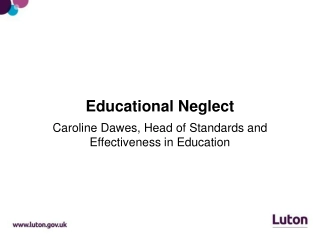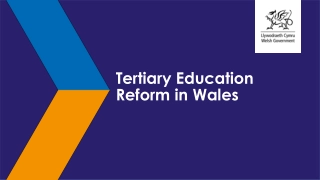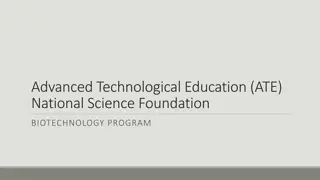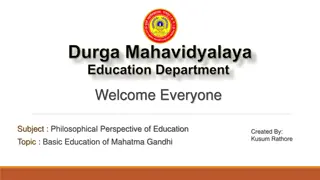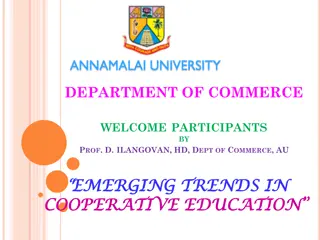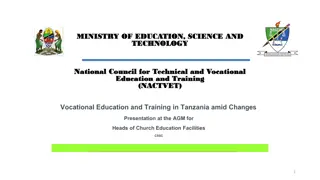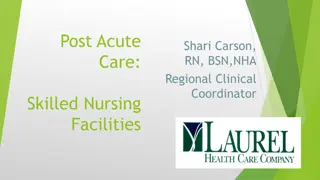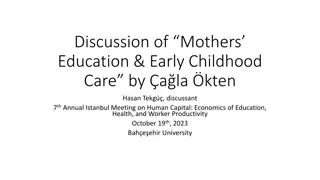
Key Concepts in In-Service Education for Healthcare Professionals
Explore the essential aspects of in-service education within the healthcare sector. Learn about the central and specific objectives, principles, benefits, and differences from continuing education. Dive into definitions, staff development, and the significance of ongoing learning in nursing. Discover the core concepts and importance of in-service education as a vital component of professional development.
Download Presentation

Please find below an Image/Link to download the presentation.
The content on the website is provided AS IS for your information and personal use only. It may not be sold, licensed, or shared on other websites without obtaining consent from the author. If you encounter any issues during the download, it is possible that the publisher has removed the file from their server.
You are allowed to download the files provided on this website for personal or commercial use, subject to the condition that they are used lawfully. All files are the property of their respective owners.
The content on the website is provided AS IS for your information and personal use only. It may not be sold, licensed, or shared on other websites without obtaining consent from the author.
E N D
Presentation Transcript
Mrs. Reena Vincent Professor JMCON
Central objective At the end of the class students in-service education and able to describe and apply while working in the clinical and educational setting
Specific objectives At the end of the class student are able Define Staff development Define In-service education Describe Concept in in-service education Enlist the Aims in-service education Explain the Nature of in-service education Explain the Scope of in-service education Explain the Need of in-service education Describe the Objective of in-service education
Principles of in-service education characteristics in-service education Approaches in-service education Factors influencing in-service education Principles in adult learning Planning for in-service education Steps /Evaluation methods Problems in in-service education Benefits of in-service education Difference between in-service education and continuing education
Let us never consider ourselves finished nurses Florence Nightingale
Definition: Staff development refers to all training and education provided by an employer to improve the occupational and personal knowledge, skills and attitude of vested employees
Definition In-service education is a planned instructional or training program provided by an employing agency in the employment setting and designed to increase competence in a specific area
CONCEPTS OF IN-SERVICE EDUCATION Planned education activities Helps a person to improve performance effectively Concept of in- service education Provide in a job setting Closely identified with services
Aims of in-service education Professional development Update the knowledge Improve the creative ability Eliminate deficiencies
Nature of in-service education It is planned activity with predetermined objectives and criteria for evaluation . Designed to meet specific needs, remove shortcoming in learning or correct shortcoming in skill of employees. Focus on more effective functioning of employees. Focus on more better functioning of the organization. Conducted with the full support of the organization.
Adult teaching principles are taken into consideration. General educational principles are also taken into consideration. The philosophy and objectives of in-service education program is in line with the goals of the health care organization.
Scope of in-service education It helps to meet the needs of the specific health care organization . It enhances the knowledge ,skill and attitude for improving the performance of present job . Provide credit points to nurses essential for renewing their nursing license by the state nursing council. Helps in standardizing methods and procedures.
Improve the quality and efficiency of patient care Help to establish high standard of nursing care to patient care. Improve communication skills and thereby team work among nurses. Provide training for special functions such as management, team building etc. Improve morale of employees.
Need Social changes and scientific advancement Changes and advancement in the field of service Increased the demand of nursing services , quality care . Rapid changes in medical and nursing practice. Nurses to function at her highest potential as quickly as possible Health care delivery system become more complex
Objectives Enhancing quality care Professional practice Latest knowledge Job satisfaction Skill development objectives of in-service education Communication skills Retain staff Discover potential Behaviour change Performance improvement Staff development
Principles of in-service program Start with most disturbing problem Work with personnel Simple organizational structure One thing at a time Simple and short term projects Give time to time Move step by step Flexibility in program
CHARACTERISTICS of GOOD IN- SERVICE EDUCATION PROGRAM It should be given in job setting . Every program should be planned and ongoing . It should be closely related and identified with service components . It should help the employees learning and improve her/his knowledge, skills and attitude.
1 .Centralized Approach Conducted by nursing personnel in the central administration of the agency. Advantages: Budget control Evaluation of program can be facilitated Prior decision on resources, people, places and things Committees are directed to work on specific problems identified by administration.
Disadvantages It may lead to in reducing spontaneous, interested participation and enthusiasm of learners.
2.Decentralized Approach It is planned by and conducted for the employees of one or more units. The employees are expected to keep administration informed of their activities, the employees are expected to develop and direct their own learning experiences.
In this approach, control in planning for a in-service is a responsibility of employees.
Advantages: Individuals are working in the same unit and confront problems are common Share the responsibilities for meeting the in- service needs Proper contribution of the participants is expected
Disadvantages: Lack of leadership Conflicts Inefficiency Less or no budget
3 .Co-ordinated Approach It is a compromise between the centralized and decentralized patterns . This approach involves both nursing administrators and practitioners in complementary way.
ADVANTAGES Mutual co-ordination and assistance to central administration is improved Duplication is avoided Unity of efforts is maintain
Orientation Skill training Areas of in-service education program me Leadership and management Continuing education
1 ORIENTATION Is the process of acquiting a new staff with the existing work environment so that he/she can relate quickly to his/ her new surroundings. Types of orientation Two types General orientation Specific orientation
Importance Provides essential ,relevant and necessary information Helps employee to gain confidence . Lessen the time for the employee to learn about new situations related to job settings Helps the new employee to develop a sense of belonging her.
Help new employees in solving initial problems and adjust the new situations /environment . Acquaints her with personnel services readily with in the institution /community.
It eliminates Learning by trial and error Passing of incorrect information by old employees and peers Reduces misinterpretation Mistakes and confusion Apprehension
The duration of orientation varies according to areas usually 3 stage processes.- Orientation to overall organization, to the specific department and to the specific job
The organization information includes history, philosophy, mission,goals,objectives,organizational structure etc. Under personnel information personnel policies, procedures, compensation issues, benefits, physical facilities etc.
The important aspects of the orientation of department includes departmental functions, activities, policies, rules and regulations, introduction to staff members of the department .
Regarding the orientation to the job Job description, responsibilities, records and reports, performance standards, supervision practices, instruction on use of equipments, monitors, regarding supplies materials and routines.
Advantages Adjust to work Be strongly motivated to learn Able to function effectively Feel wanted and needed by co-workers and supervisors.
2 Skill Training Program Skill training may be a manual or technical skill of doing for people It provides the nursing staff with the skills and attitude required for job and to keep them abreast of changing methods and new techniques. Often it is the continuation of the orientation program. It is designed to new and older staff.
OBJECTIVES To help the nursing personnel to perform correct methods and procedure with understanding . Establishing standards and quality of services . Procedure to skill nurses to skilled nurses.
TYPES OF SKILLS Psychomotor skill Cognitive skill Teaching skill Affective skill Communication skill Supervisory skill
Training principles The trainee must be motivated to learn Learning must be reinforced Materials must be meaningful and communicated Multiple senses learning should be applied The material taught must be transferred to the job situation Feedback is must to achieve required and appropriate learning .
3 .Leadership and management development To improve the managerial abilities of persons at every management level as well as potential managers to produce the greatest degree of organizational progress. Need can identified by incident reports, turnover rates, patient audits and quality control reports.
Objectives De centralize leadership management competency Permit increased delegation of authority Promote good morals among administrative personnel Reducing turn over in top positions
The areas of leadership and management Self confidence Communication skills Leadership skills Mentoring hiring and training employees Developing esteem from peers and direct reports Eliminating public speaking fear
4 .Continuing education Continuing education is all the learning activities that offer an individual has completed his basic education. cooper
Aim of continuing education Improvement of professional practice . To motivate the staff to seek the latest knowledge. To keep the nurses with the latest development of technologies . It develops interest ,job satisfaction, and confidence.
Need for continuing education To develop employee by updating the knowledge It helps employee to respond effectively to the challenges of current social changes It helps to improve the health care economic and educational opportunities It helps to improve the new health pattern of healthcare Enable to provide excellence service Ensures professional development Aids in career advancement
Extramural education It is a community based continuing education directed towards meeting job related learning and other personnel example conferences seminars etc
FACTORS INFLUENCING IN-SERVICE EDUCATION Cost of healthcare it adds additional expenditure on health care delivery system. Manpower need qualified human resources, leads to increase human resources. Changes in nursing practices it leads to frequent changes in the program. Standards : very important to maintain the highest standards of nursing practice.
Principles of adult learning 1 Need assessment what is to be learned . 2 Safety in the environment &the process context for learning made safe . 3 Sound relationship- between teacher and learner among learners . 4 Sequence of context and reinforcement. 5 Learning by doing . 6 Respect for learners as decision makers .

